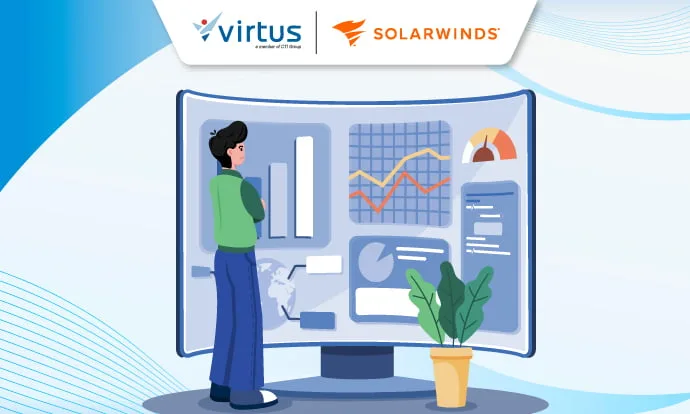Does your company frequently encounter unexpected IT issues? Problems often arise from hidden parts of the system that are difficult to identify. With modern architectures like microservices, cloud, and distributed systems, these unforeseen issues can surface at any moment without warning. This is what we call “unknown unknowns”—unpredictable problems that are hard to anticipate.
To tackle these challenges, modern businesses need more than just traditional monitoring tools. Observability offers deeper insights, allowing IT teams to detect potential issues early, investigate their root causes, and resolve them before they impact business operations or disrupt the user experience.
But what exactly is observability, and why is it vital for keeping your IT systems running efficiently, especially as your infrastructure grows more complex with business expansion? Keep reading to learn how observability can help your company maintain a stable and resilient IT environment, prepared to address unexpected issues swiftly and effectively.
What is Observability?
Observability is the ability to gain deep visibility into the internal state of a system by analyzing its external outputs, such as logs, metrics, and traces. In the IT context, observability helps IT teams understand how applications, infrastructure, and networks are functioning, making it possible to detect issues that traditional monitoring tools may miss. With observability, businesses can spot problems early, find the root cause quickly, and resolve them efficiently, ultimately improving the performance and reliability of their systems.
What’s the Difference Between Observability and Monitoring?
Although observability and monitoring serve different roles, they complement each other to ensure optimal system performance. Here are the key differences.
| Aspect | Monitoring | Observability |
| What it does | Tracks specific metrics like CPU usage or memory. | Understands system activity holistically, including unexpected events. |
| When it functions | Alerts you after an issue occurs. | Helps detect and resolve problems before they happen. |
| Focus | Focuses on known and anticipated issues. | Focuses on unexpected problems that haven’t been identified yet. |
| Data used | Simple metrics like logs and resource usage. | Deeper data from logs, metrics, and traces. |
| How it works | Sends alerts when thresholds are breached. | Provides comprehensive analysis that helps IT teams fix problems faster. |
| Purpose | Ensures systems run according to predefined parameters. | Identifies and resolves unknown issues more quickly. |
Why is Observability Important?

Observability works like a detective, investigating the root causes of problems before they grow and cause bigger issues. With observability, IT teams can detect anomalies early, analyze unusual patterns, and quickly find solutions before issues impact the system. Just like a detective piecing together clues, observability collects data from various sources to create a complete picture of the performance of applications, infrastructure, and networks.
Without observability, businesses only become aware of problems after disruptions occur, leading to downtime and operational delays. A system without observability forces IT teams to be reactive instead of proactive, slowing down the response to issues. Undetected downtime can significantly affect productivity, increase operational costs, and harm the user experience.
How Does Observability Work?
Observability provides full visibility into systems by collecting and analyzing real-time data. This process involves several key steps that work together to ensure optimal system performance.
Data Collection
Data is collected from various system components, including logs, metrics, and traces.
Data Storage
Once collected, the data is stored in a system designed to handle big data with fast access.
Data Analysis
The stored data is then analyzed using AI and machine learning to detect patterns, trends, anomalies, and potential problems.
Data Interpretation
The analyzed data is interpreted by IT teams to find the root cause of the issue and determine the necessary actions to resolve the problem quickly and effectively.
Benefits of Observability
Observability plays a crucial role in managing modern IT infrastructures. With this capability, businesses can improve system resilience and tackle operational challenges effectively. Here are some of the key benefits that observability brings.
Solving Unknown Unknowns
Observability helps IT teams identify unexpected problems that haven’t been predicted before, providing visibility into areas of the system that monitoring often overlooks.
Improved Visibility
Allows for comprehensive monitoring of system performance, ensuring every component can be analyzed in detail for a better understanding of how the system works.
Proactive Problem Detection
Observability enables IT teams to detect problems earlier, allowing them to act before the issues impact users or business operations.
Accelerated Problem Solving
With deeper data and analytics, observability speeds up the process of finding the root cause of problems and helps IT teams resolve them faster.
System Performance Optimization
Helps businesses better manage their IT resources, ensuring systems run efficiently and reducing the risk of downtime that could disrupt operations.
Read More: Network Monitoring: The Key to a Stable and Uninterrupted Office Network
Improved User Experience
Ensures a smoother user experience by minimizing service disruptions and keeping applications stable.
Challenges of Implementing Observability
While observability offers significant advantages, implementing it in complex infrastructures can be challenging. There are several obstacles that organizations need to overcome during the implementation process.
Infrastructure Complexity
Managing infrastructures that consist of various technologies like cloud, microservices, and containers can make data collection and analysis more difficult and complex.
Data Volume and Variety
Modern systems generate vast amounts of data in various formats, making it harder to manage this data efficiently without advanced systems in place.
Read More: SolarWinds Database Performance Analyzer: Database Management Solution for the Financial Industry
Integration Requirements
Observability requires integrating different systems and tools, which may use different protocols or standards, creating challenges in ensuring seamless collaboration between all components.
Technical Expertise
Implementing observability requires specialized skills such as data analysis and programming, which might not be readily available within all IT teams.
Data Security
Ensuring the security of sensitive data during the collection and analysis processes is crucial to maintaining compliance with regulations and protecting system integrity.
To ensure smooth observability operations, businesses need a solution that integrates easily and provides full visibility into the entire IT infrastructure. SolarWinds Observability is a comprehensive solution that ensures IT issues can be detected and resolved quickly and efficiently.
Boost Your IT Performance with SolarWinds Observability
SolarWinds Observability is an observability solution that offers full visibility into the entire IT infrastructure, including applications, networks, databases, and cloud environments. With features like AI-driven insights and predictive analytics, SolarWinds allows IT teams to detect issues early and analyze data in-depth, preventing disruptions that could affect business operations. Additionally, SolarWinds supports hybrid environments, enabling seamless monitoring across both cloud and on-premises infrastructures.
SolarWinds provides a superior solution for simplifying the management of complex IT infrastructures, increasing service availability, and speeding up problem resolution with machine learning-based analytics.
Key Features of SolarWinds Observability
SolarWinds Observability comes equipped with advanced features specifically designed to enhance IT infrastructure performance. Here are some of the standout features that help businesses maintain the stability and efficiency of their systems.
Cross-Stack Visibility
Offers a comprehensive view of networks, applications, databases, and cloud environments, providing full visibility across all layers of technology.
AI-Driven Insights
Utilizes AI to deliver predictive analytics, identifying trends and potential issues before they impact operations.
Customizable Dashboards and Alerts
Provides customizable dashboards to meet specific business needs, along with real-time alerts to monitor critical issues.
Integrated Troubleshooting
Includes built-in tools for deep analysis and troubleshooting, helping IT teams diagnose and resolve issues more efficiently.
Cloud and On-Premises Monitoring
Supports monitoring for hybrid infrastructures, ensuring smooth integration between cloud and on-premises environments.
Benefits of Using SolarWinds Observability
SolarWinds Observability helps businesses optimize IT performance and speed up problem resolution. Here are some of the key benefits of SolarWinds Observability.
Increased Service Availability
Ensures maximum uptime by identifying and resolving problems before they affect users.
Faster Problem Resolution
With real-time insights, SolarWinds accelerates troubleshooting and reduces downtime significantly.
Lower Operational Costs
Optimizes resource usage and prevents costly outages.
Increased Team Productivity
With automated and streamlined workflows, SolarWinds enables IT teams to work more efficiently.
Data-Driven Decision Making
SolarWinds provides data and analytics to support better decision-making.
Comprehensive Visibility
Offers a full view of the entire IT infrastructure, ensuring IT teams understand how every component affects system performance.
Scalability
Can be scaled to meet growing IT needs, whether in the clouds or on-premises.
Integration with Other Tools
SolarWinds integrates with other IT tools, providing a unified solution for the entire IT ecosystem.
Get the Best Observability with Virtus
As an authorized distributor of SolarWinds, Virtus offers comprehensive observability solutions to help your business modernize its IT infrastructure efficiently and effectively. With SolarWinds Observability, you will gain full visibility into your entire IT system and be able to detect issues early before they affect your business.
Virtus will support you throughout the implementation process, from consultation to after-sales support, with a team of certified professionals. For more information, contact us through the following link.
Author: Danurdhara Suluh Prasasta
Content Writer Intern CTI Group

